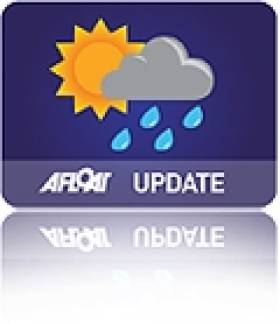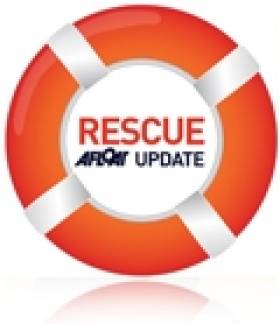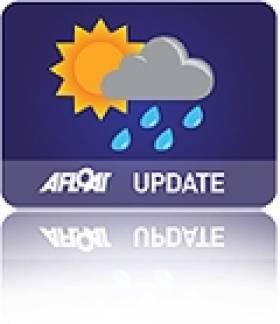Displaying items by tag: Weather
Summer Gale Threatens Sailing Fixtures
#weather – A deep area of low pressure off Southern Ireland with fronts pushing north threatens to disrupt a number of sailing events on the Irish Sea from this afternoon including tonight's regular Dublin Bay Sailing Club (DBSC) 200 boat plus racing and even tomorrow night's fiftieth Ailsa Craig race from Belfast Lough.
South easterly winds will be increasing and gales are expected today. Thickening cloud and outbreaks of rain through this afternoon. The rain becoming more persistent as the day progresses.
Depending on how fast the fronts move weekend sailing may also be affected, the hope being that the gale will have passed through before the Ruffian Nationals begin at the Royal St. George Yacht Club in Dun Laoghaire and the Laser Leinster championships start in Howth.
There will be further rain through this evening, this becoming heavy at times.
Winds will be to gale force later, and visibility will become increasingly moderate in rain, then poor later. Sea state will be rough then very rough.
Dun Laoghaire marina has issued a forecast that warns of SE 25-28kt - SE 30-38kt from 6pm this evening.
#MARINE WARNING - A small craft weather warning is in effect today as strong easterly winds bring heavy rains sweeping across Ireland.
Met Éireann reports that strong gales between force 5 and 6 are developing this morning on all coasts and on the Irish Sea, with northerly gales set to develop on western and southern coasts this afternoon, and speeds in most places expected to reach force 8 or 9.
Winds may even reach storm force 10 between Roche's Point and Slyne Head by the end of the day.
In addition, Irish Coast Guard manager Declan Geoghegan told the Press Association that local flooding is likely throughout the country - especially in Connacht, which may experience up to 60mm of rainfall - and warned the public not to attempt crossing fast-running rivers or fords.
“The combination of tides, forecasted high winds in the coming days and swollen rivers may result in very dangerous conditions," he said.
The Irish Times has more on the story HERE.
#WEATHER - The Irish Times reports on video of what appears to be an over-water tornado or 'seaspout' off the coast of Sligo last week.
The video above was captured at Rosses Point on the afternoon of Monday 7 May by Graeme Salter.
“I’ve been going to Rosses Point since I was a child and have seen some mad weather, but never anything like this,” he said.
Seaspouts or waterspouts are most often associated with dark, flat-bottomed cumulus cloud formations. They are not true tornados in the strictest sense, as they are not formed by the rotating updraft of a supercell thunderstorm.
The footage is the second occurrence of a waterspout in Ireland in recent weeks, following the mini-twister filmed at Bray Head last month as a massive thunder, lighting and hail storm hit the capital, as previously reported on Afloat.ie.
#STORMS – May Day and the first day of Summer 2012 today brings little in the way of joy for boaters on the east coast of Ireland at least who have suffered early season set backs from gales since the beginning of April. Prolonged storm force winds and big seas have wrecked boats, equipment, jetties and piers along the coast.
Many yachts and boats are now safely sheltered in the capital's marinas at Dun Laoghaire, Malahide and Howth but sadly for other skippers it is too late and the 2012 season lies in tatters.
Today's forecast shows another poor week in prospect and while the weather is to improve for next weekend's bank holiday it is not to the extent that it will be a memorable one with cold northerly winds forecast and temperatures of only 9 degrees until next Tueday at least. It seems hard to imagine that in March Ireland was basking in temperatures in the low 20s.
Storm damage is still being assessed in Skerries and Bray where most of the damage has occurred.
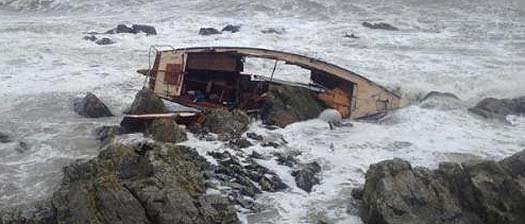
Yachts lie wrecked on the rocks in North Dublin. Photos: Dean Jacobs
Less than a week since the boats were craned in at Skerries Sailing Club ISORA champion yacht Raging Bull, skippered by Matt Davis, was on the rocks.

The yacht was among others to be washed ashore in Skerries in north Dublin when moorings apparently broke in the extreme conditions.
In Bray Co. Wickow, no sooner had crews lifted boats in than the crane was back in action lifting Sailing Club yachts out of the harbour again only some were not so lucky.
There is little doubt about the severtiy of the storms that even caused problems in Dun Laoghaire, Co. Dublin where the yacht club pontoon at the Royal St. George Yacht Club was damaged in the first of the storms.
Amazingly through all of this yacht club racing programmes have been followed without a hitch except for the SB3s scrubbed last Sunday. Howth concluded its Spring Warmer series, DBSC has had two great Saturday race days and in between gales the ISORA fleet raced 47 miles from Dun Laoghaire to Wicklow and back.
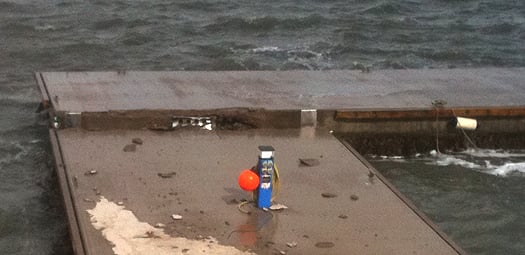
Damage to yacht club pontoons inside Dun Laoghaire harbour
The new harbour in Greystones was also tested this month and there were many onlookers. The consensus appears that it s been well built but over-topping (where waves can crash over the top of the brekwaters) might make berths in the new marina basin inhospitable when the marina is eventually installed there.

Waves crash over the new harbour walls in Greystones in the first week of April
We are documenting the damage to boats causd by the gales. If you have photos or videos please send them to [email protected]
'One Epic Day of Huge Surf' Caught On Film
#SURFING - A new short film tells the story of "one epic day of huge surf" at Mullaghmore Head, as Surfer Today reports.
The Northcore film 'Fathoms Left to Fall' follows some of the world's top big wave surfers as they converged on Co Sligo to take advantage of the swell, prompted by the extreme weather system known as the 'Viking storm'.
Among the Irish riders featured is 24-year-old Ollie O'Flaherty, who has been nominated for the 'biggest wave' prize in the 2012 Billabong XXL Big Wave Awards for his monster ride at Mullaghmore.
Also nominated for his outstanding effort at the Sligo surf mecca is Andrew Cotton, a Devon native who's no stranger to Ireland's big rollers.
Bray Head 'Tornado' Footage Captured on Youtube
#TORNADO – A mini-twister, a tornado or waterspout made a spectacular appearance off Bray Head, County Wickow this morning and was captured on tape and posted on youtube by user at the same time as a lightning, thunder and hail storm hit Dublin Bay.
The UK Met Office warned earlier this week that a combination of warm ground temperatures and cold wind passing from the north west could create the perfect conditions for funnel clouds but little did we relaise it would turn up on the East coast of Ireland and only a short distance from where over 200 youths are competing in the Irish Youth Sailing Championships on Dublin Bay.
The YouTube clip above was captured by user 'aoifeno1' (East Coast Kayaks) and uploaded this morning under the summary: "Just about to take a photo of sunrise when I spotted this twister!"
Another clip was caught on tape at 6:40 after a sudden storm passed right overhead, the poster said 'hail came pummeling down and this waterspout went right past the beach and broke up when it hit land on Bray Head'.
Second Cruiser in a Week Runs Aground in Lough Erne
#RESCUE - Four people were rescued on Lough Erne yesterday after their motor cruiser ran aground in the second such incident in a week, the Belfast Telegraph reports.
All on board were retrieved by RNLI lifeboat from the 29ft cruiser, which is believed to have stranded on rocks beyond the marked channel of the lough.
No injuries or damage to the vessel were reported, with a Northern Ireland Coastguard spokesperson describing it as "a routine rescue".
The coastguard blamed low water levels in the lough caused by lack of rainfall in Co Fermanagh.
Waterways Ireland has posted a marine notice warning boat users of the risks posed by "the extended period of unseasonal dry weather" for Ireland's inland waterways.
In a similar incident last Friday, three adults and two children were rescued from a cruiser that stranded in shallow water on the lough.
The Belfast Telegraph has more on the story HERE.
UK Laser Sailors in £50K Irish Sea Crossing Challenge
#LASER - A pair of British sailors are set to embark on an intrepid crossing of the Irish Sea using just two single-handed Laser dingies.
David Summerville and Steve Cockerill had originally planned to make the crossing in September last year, but those plans were scuppered by 50-knot gale force winds and a 12-foot tidal swell, according to Incentive Travel.
But the duo is now planning to try again, with the backing of the Ramada Plaza Southport.
“David and Steve will be covering 115 nautical miles during the challenge," said Ramada Plaza general manager Enda Rylands. "They will set off from my own home town of Dublin and finish in Southport, aiming to raise £50,000 for mental health charity Mind and the John Merricks Sailing Trust."
Summerville, a 53-year-old grandfather of two who runs a boat repair business, said the date of the challenge would again depend on weather and tidal conditions, and that the pair is ready to depart any time from mid-April to mid-September.
It's not the first time that an Irish Sea crossing has been done in a Laser as Tiffany Brien achieved the feat in 2010, sailing single-handedly the 30 miles from Portpatrick in Scotland to Belfast Lough.
But Summerville and Cockerill's ambitious undertaking, at more than three times that distance, would surely get them a place in the record books - provided the weather goes their way!
#MCIB - The families of two fishermen found dead at sea off the Skerries last April may never uncover the circumstances that led to their demise. But the official report into the incident indicated that the absence of lifejackets was a significant contributing factor.
Ronan Browne (26) and David Gilsenan (41) were reported missing on the evening of 1 April after failing to return from a trip tending to lobster pots.
Their vessel, Lady Linda, was found the following morning upturned in an oil slick off Clogherhead with no sign of the crew.
It wasn't until a week later that their bodies were discovered caught in the vessel's fishing gear some five miles east of Clogherhead, as previously reported on Afloat.ie.
Post-mortem results found that both men died from drowning, with Gilsenan also showing signs of hypothermia.
With no eyewitnesses to the incident, the report by the Marine Casualty Investigation Board (MCIB) indicated a number of possible causes from eqiupment malfunction or shifting of lobster pots on deck, to the wave height and weather conditions on the day, which were reportedly deteriorating when the boat left port.
It also said that Browne and Gilsenan "were lifelong friends, both men were experienced and qualified marine engineers in the fishing vessel industry. Both men were experienced in boat handling and fishing and had worked together on many occasions."
But the report emphasised the lack of personal flotation devices (PFDs) on board, and noted that emergency equipment was stored under the deck and not easily accessible.
The MCIB's recommendations include a review of the code of practice for fishing vessels under 15m to establish "revised stability critera" and ensuring that all boats are fitted with automatic radio beacons that deploy upon capsize.
In a separate incident, lack of proper maintenance led to an unlicenced boat taking on water off Co Kerry last August.
The Claire Buoyant was carrying one crew, five passengers and 21 sheep from Beginish Island to Ventry when the vessel began to lose stability.
Skipper Eoin Firtear - who the MCIB described as having "limited sea-going experience" - and his five passengers were rescued by passenger ferry. All sheep were jettisoned overboard, with 18 eventually recovered.
The report reminded that the carriage of livestock should only be undertaken in appropriately certified vessels.
- MCIB
- Marine Casualty Investigation Board
- report
- Lady Linda
- Clogherhead
- Ronan Browne
- David Gilsenan
- lobster pots
- Fishing
- drowning
- hypothermia
- missing
- malfunction
- wave height
- Weather
- lifejackets
- Personal Flotation Devices
- PFDs
- Code of Practice
- stability
- Radio
- beacon
- maintenance
- unlicenced
- Co Kerry
- Claire Buoyant
- Sheep
- Passengers
- Beginish Island
- Ventry
- Eoin Firtear
- Skipper
- Rescue
- Livestock
Help Record Old Weather Data to Predict Climate's Future
#WEATHER - A new project has been launched encouraging web users to help recover worldwide weather data recorded by Royal Navy ships a century ago.
Old Weather is 'crowdsourcing' volunteers to assist in transcribing weather readings and location data from First World War ships' logs into a database, in order to identify weather patterns and extremes the world over.
At present the site needs help transcribing data from 27 Royal Navy vessels and the courses they sailed, from Britain and Ireland to the farthest reaches of the globe.
The more people that take part in Old Weather, the more accurate the data extracted from the ships' logs will be.
Each logbook will be also looked at by more than one person, allowing mistakes and errors to be filtered out.
The historical data will enable scientists to improve their understanding of weather variabilty in the past and in turn improve their ability to predict weather and climate in the future.
For more details visit www.OldWeather.org.































